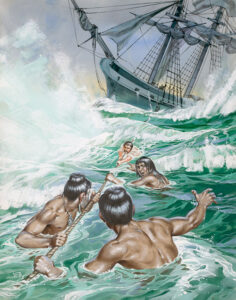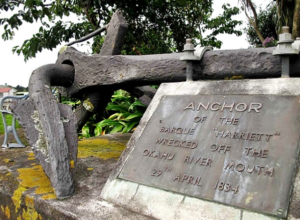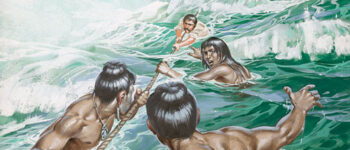1863: Martin Crossing the Delaware
September 4, 2022
By AHNZ

Today in history, 4 September, 1863, a remarkable cultural change was marked in New Zealand history. By the evidence of a brave rescue at Delaware Bay, Nelson, Maoris had transitioned from being a Tragic Society to a Therapeutic Society. In other words, they helped rather than pillaged the needy. That was a very great change worthy of remarking upon.
First, the incident itself. The previous night the coastal trading ship Delaware had been wrecked on the rocks at Whakapuaka having made it not very far from the port at Nelson on the way to Napier. According to the master of the ship, Captain Baldwin, all the stranded crew and single passenger would have died if not for the help of the Whakapuaka Maoris.
The lead rescuers were Mr James Martin and his wife Julia Martin (aka Mr Hemi Matenga & Huria Matenga.) They, with 3 of their friends/family, braved the stormy surf to collect a rope line to the shore. This was no easy task as it had already been attempted by the Delaware’s first mate Henry Squirrell, the only crewman who could swim. Squirrell had been bashed against the rocks and reeled back in like a broken fish. Too injured to escape, the wounded Squirrell was the only man left after the rescue and his dead body washed up on the beach next morning. Ironically, the only man on the ship who could swim was the only man to drown.
“but for the bold and unwearied exertions of the Maoris, he did not believe one man would have been saved from the wreck.” – Captain Balwdin, New Zealand: History & Natural History, Facebook (2018)
“The captain went below and saw the mate, who appeared to be dead. So he started for the shore. The rope broke, and he would have been drowned had not Julia Martin and her husband rushed in and rescued him. Then the mate appeared on deck. Those on shore shouted to him to lash himself to the rigging, and when the tide went out they would save him. Probably he was not able to do this. A sea broke on board, and his body was found on the beach next morning. And so it came to pass that the only man on board who could swim was the only | one drowned.” – HEROISM RECALLED, Hawera & Normanby Star (1922,) Papers Past
Now came the politics. Certainly the young Maoris in their physical prime had done a great deed running the rescue line and aiding exhausted men to rescue. Certainly thanks were owed. However, because of the political context the incident yielded up a legendary folk history with Gottfried Lindauer cosplay oil paintings, an Angus McBride watercolour, award ceremonies, Mayors, Superintendents, Governors General, gold and silver watches, and cash prizes!
To understand this, realise that 1863 was the time of the Waikato War. There is no such thing as the ‘good old days’ so the Government back then was as concerned with propaganda as ours is today. Its agenda was to emphasise and celebrate friendly cooperative Maori New Zealanders. All the better to show what outliers and traitors the rebel Maoris, especially the Waikato tirbes, were.
To this end Julia Martin was elevated above the other rescuers, the better to elicit public sympathy. Her Maori name, Huria Matenga, was emphasised. Even at her death Julia was portrayed in an oil painting by Lindauer with the founding Delaware in the back ground even though she was an old women then (and looking rather like Winston Peters with long hair.) Julia was entitled ‘The Grace Darling of New Zealand’ after a famous Englishwoman rescuer a couple of generations prior. And, Julia was given a gold watch while the others silver. It’s far from clear that Mrs Martin played a greater role in the rescue at all but the political story benefited greatly from such a notion so that’s the one that the Public Relations people in the government laid down.
“The presentations were made to the heroic Maori by provincial superintendent John Robinson on 14 November, before a packed audience at the Provincial Hall in Nelson. Huria received a gold watch and chain while each of the men received a silver watch and chain. The sum of 50 pounds was also presented by the provincial government to each of the five rescuers.” – Alan Turley, Nelson Weekly (c.2020)
“Accounts of Hūria Mātenga’s part in the rescue conflict, but it seems probable that she was one of those who swam into the surf to pick up a lead line thrown by the captain. A hawser was fastened to a boulder on shore, but by this time the storm had become so fierce, and the ship was rolling so badly, that the line continually slumped into the water. Hūria Mātenga and two of her companions swam out into the surf and helped the crew ashore. ” – Dictionary of New Zealand Biography, Te Ara – the Encyclopedia of New Zealand
“The Suter Memorial Art Gallery was crowded to excess yesterday afternoon when the Governor unveiled the memorial portrait of Julia Martin, the Grace Darling of New Zealand… His Excellency said he had very great pleasure in unveiling the picture…He had no doubt they all felt a keen interest in the Maori race, and regretted that it was a dwindling one.”
“Mr Park, of Motueka, by the aid of an interpreter, thanked them for the honour that had been paid that afternoon to one of the Maori people. The Maoris ‘felt it was honouring them. Tho Maoris felt pleased that they were under the British flag, and members of the great British Empire. They felt that they would not have fared so well under any other nation, and he instanced the treatment the Jews had received in Russia.”
“The Governor was presented with a souvenir of his visit, in the shape of an album…an excellent picture of the Suter Art Gallery, a photograph of Mrs Julia Martin’s memorial portrait, a coloured sketch, of the scene where the Delaware was wrecked and a photograph of the Maori pah, where the late Mrs Martin lived.” – Colonist (1910,) Papers Past
Nelson’s Superintendent John Robinson was right to appreciate coastal lifeguards. Within 2 years, and still in office, he would die for want of one. Ref. 1865: Superintendent Nelson Missing to this Day
It would be great to see the album given to Governor William Plunket and the coloured sketch of the scene. I’ll write some emails the the Plunkets and the Governor General and see what comes back.
Certainly the Martins did not need money and watches and honors per se. They were a noble and wealthy family and had it made. But many noble and wealthy families, even today, send their young out to achieve feats of athletic excellence to make their names. If not for them nobody would be wealthy enough to afford to be able to compete in things like the Commonwealth Games, Olympic Games, cycling, horse-riding, international sailing competitions etc.
Tragic Society to a Therapeutic Society

The idea that a Maori would rescue anyone in the 1860s was still a fairly new cultural evolution that was foreign only a generation or two before. As recently as the 1830s the pre-Christian Maoris viewed misfortune very differently. For example, when the Harriet was wrecked on the Taranaki coast the survivors were attacked, plundered, killed, eaten, looted, and imprisoned by the Maoris. Ref. 1834: The Harriet Affair
When these are the kind of savages you’re dealing with it’s no good being kind or understanding, as the victims found. The policy in responding to that sort of culture must be different. There’s no reasoning with the unreasoning on negotiating with the primitive. Hence, a rescue mission for the Harriet was launched which left Sydney on HMS Alligator which bombarded the Maori pa and shot the tribesmen before burning down their village. 1834: See You Later With The Alligator
In a Therepeutic Society our perspective on people in need is that we ought to help them. Rescue them. Save them. Feed them. Heal them. If they lose their ride we offer them a lift. If they’re short on money we offer them some. A help-up, not a hand-out. Our shield of Inclusive Fitness extends over them because we empathise. They’re part of our extended family and, we suppose, they would do the same for us. This is what James and Julia Martin did, even at their own risk, for the Delaware. Earlier generations would have- did – let the crew die and pillage the survivors.
This is why why crossing to the Delaware represents a key event marking a cultural evolution in the Maori-Zelandian. It is as important to our national history as is Washington Crossing the Delaware for the American Revolutionary War. It’s almost as if water and ships and the word ‘Delaware’ are ingredients for revolutionary acts and future oil paintings…
“Washington Crossing the Delaware is the title of three 1851 oil-on-canvas…paintings commemorate General George Washington’s crossing of the Delaware River with the Continental Army on the night of December 25–26, 1776, during the American Revolutionary War. That action was the first move in a surprise attack and victory..” – Wiki
If a man’s child fell into the fire and was severely or perhaps fatally burned, he was plundered of nearly everything he possessed, and the same was the case if his canoe upset while he was fishing, or any other accident happened to him..”- Ref. ‘The Boy Travellers in Australia’ (1888)
“In traditional Maori thought survivors from calamities were not seen as fortunate, inasmuch as they were considered to be tragic figures in themselves. In all cases of Ngai Tahu traditions that tell of survivors from failed campaigns returning to their kin, the lives of the survivors are endangered by the host people.” Te Maire Tau (2011)
We must remember that New Zealanders in this era were locked in a long Honour Culture (HC) phase. Sectarian tribes scrambled to survive in a Mad Max world where superstition and paranoia were virtues. An HC’s worldview tells him that bad luck events like accidents and shipwrecks are personal to the victims. It’s a signal that this person is out of favour with spirits and gods, they are marked as sinful and unfaithful and are fair game according to the law of muru.” – 1834: The Harriet Affair, AHNZ
“Are you a fighter, or are you food?” ―Lead Scrapper, Thor: Ragnarok (2017)
 In the Tragic Society the perspective of a person in need is that they are faulty. Damaged. Cursed. Abandoned by the gods, a tragic figure that has lost his personhood and is now a resource to be exploited; Food. If someone alien to the tribe, who doesn’t meet Inclusive Fitness in terms of belonging anyway, is weak then what better time to exploit them before someone else does the same? If someone from your own tribe has allowed themselves to be come shipwrecked or weak then they are broken and their energy and resources ought to be re-absorbed by the strong. This is barbarism belonging to the past of all human cultures but also explored in distopian futures such as the Mad Max movie series. We could go backwards to being a Tragic Society again and perhaps Maoris did do this. Perhaps the Moriori or the Waitaha had evolved to a Thereputic Society in New Zealand, or on the ancestral islands, but when the moa ran out or the Little Ice Age (14th century through the mid-19th century) struck a new Tragic Society Maori took over?
In the Tragic Society the perspective of a person in need is that they are faulty. Damaged. Cursed. Abandoned by the gods, a tragic figure that has lost his personhood and is now a resource to be exploited; Food. If someone alien to the tribe, who doesn’t meet Inclusive Fitness in terms of belonging anyway, is weak then what better time to exploit them before someone else does the same? If someone from your own tribe has allowed themselves to be come shipwrecked or weak then they are broken and their energy and resources ought to be re-absorbed by the strong. This is barbarism belonging to the past of all human cultures but also explored in distopian futures such as the Mad Max movie series. We could go backwards to being a Tragic Society again and perhaps Maoris did do this. Perhaps the Moriori or the Waitaha had evolved to a Thereputic Society in New Zealand, or on the ancestral islands, but when the moa ran out or the Little Ice Age (14th century through the mid-19th century) struck a new Tragic Society Maori took over?
At any rate, it was Maori as a Tragic Society that the West discovered and a state that remained well into the Colonial era. Certainly there are still members with this Tragic outlook alive today who pass this forward to their children with a continuity back to antiquity. It’s no wonder that Maori medicine and housing and technology was stuck in a rut. How can you advance when it’s not safe to make mistakes? How can meet your security needs when those close to you are watching with hungry eyes to dismember you if you ever even appear to show signs of tragic weakness? Good for a collective like a tribe, deadly to individual liberty and intimacy and creative innovation.
That rope crossing from the turmoil and death and wreckage of the Delaware to the firm, safe, supporting terra firma is highly symbolic of the cultural journey from Tragic to Therapeutic New Zealand. The metaphore extends by showing that the relief rope could not be secured by one white man alone but by of Anglo-Zealandian and Maori-Zelandian cooperation. The fate of the man who tried was to be left to the same fate as the Delaware and the proof was his broken body washing up on the beach after. It’s the sort of thing that could be a great church sermon or a graphic novel or even a short film; And ought to be.
James and Julia Martin and their 1863 group represent a new branch of Maori-Zelandian that had come a long way since the 1834 Harriet Affair. There may be other marker incidents in the years between also worth recording in our history as the new Theraputic Ethic spread through the Maori world. The Martins were innovators for their people and could afford to be. They were bourgeois, monogomous, married, tribal nobility, wealthy, palatial, island-spanning land-owning, non-tattooed, Anglican. They used English names instead of or along with Maori names. James was the son of a New South Wales whaler and trader, George Stubbs, one of Te Rauparaha’s vassal captains at Kapiti. James “was educated under Bishop Selwyn at the Native College at Auckland¹” as was (I assume) brother William (Wiremu Parata) served as a Minister in Central Government.
Lead citizens like these are the ones to form a bridge to a new way of life that others can follow. Julia Martin used her Anglo-Zelandian name but politics and folklore dress her up more as ‘Huria Matenga’ the same way that they put her ‘golden’ heroism ahead of James’ ‘silver’ heroism. Likewise, aided by the consistently complicit Lindauer, history dressed Julia up in pre-Colonial Maori cosplay garb for her oil paintings that Maoris had not dressed in (except for tourists) for several generations. Ref. 1900s: Fake Plastic Maoriland, AHNZ
Perhaps this story from our New Zealand history isn’t told as often these days because the folklore has been built on these shaky facts. So, we miss out on a great and important story because it cannot be separated from a narrative that also exposes these silly conceits. The cosplay name and clothing, the artificial elevation of the women over the men. Anarchist History has no such qualms about disrupting these stuffy old tropes. They too were made up to serve a use, eg. for Waikato War propaganda, and are part of the history we have to tell.
—
1 Ref. James Martin obituary, Nelson Evening Mail (1912,) Papers Past
Image ref. Maoris to the Rescue, Angus McBride (1970,) The Illustration Art Gallery/The Book Palace
Ref. Portrait of James Martin, Museum of New Zealand
Note: See also, 1836: Tarore Immortalised. Another culturally revolutionary incident in Maori Culture.
Update 7 Sep, 2022: Emailed the Nelson Provincial Museum asking if they knew anything about the gift to Lord Plunket. No dice. Have also contacted current Lord Plunket but not heard back.
On 2022-09-07 04:25, Darryl Gallagher wrote:
> Hi Rick,
>
> I’ve had a search of our database for this but haven’t found any
> matches. I’m sorry I have no idea where else this might have ended
> up.
>
> Best regards,
> Darryl
>
> Darryl Gallagher
> Senior Curator, Photography
> darryl.gallagher@museumnp.org.nz
> Nelson Provincial Museum Pupuri Taonga o Te Tai Ao
 Like Comment Share
Like Comment Share





